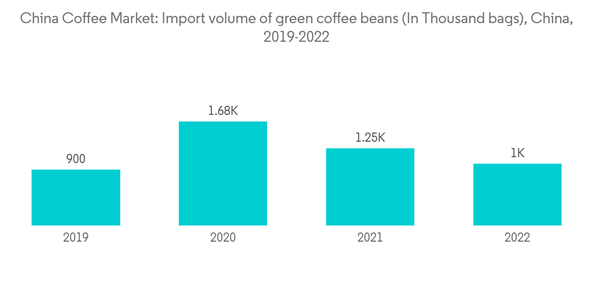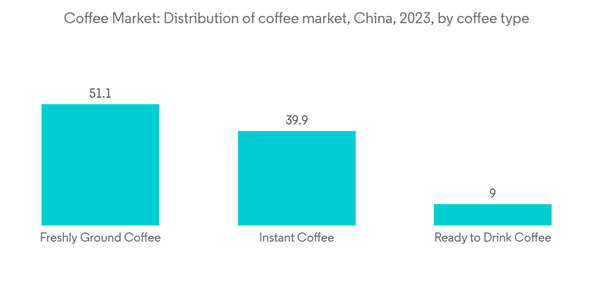The Chinese coffee market size is estimated at USD 2.1 billion in 2024. It is projected to reach USD 2.3 billion by 2029, registering a CAGR of 1.90% during the forecast period (2024-2029).
Further, product innovations are expected to aid the market growth during the forecast period. Players are innovating with products to differentiate product offerings and broaden the customer base. For instance, in August 2022, Zhongxuegao, a Chinese brand dubbed the 'Hermès of ice cream' for its premium prices, unveiled a new coffee pop-up product in nearly 600 cafés in China. The products included a blend of Zhongxuegao's almond and yogurt-flavored ice cream with cold-brew coffee, while others added Japanese probiotic milk beverage Yakult or jasmine green tea. Thus, many private-labeled companies launched their versions of coffee RTD cocktail drinks to satisfy the increasing demand for coffee and spirit-based RTD offerings.
This product will be delivered within 2 business days.
Key Highlights
- The growing demand for coffee in China can be attributed to a resilient chain of international and domestic coffee shops, such as Luchin Coffee and Starbucks, that have expanded significantly in China, making coffee more accessible and familiar. Further, the perceptioion of coffee as a health-conscious choice when consumed in moderation by consumers has contributed to its popularity. In addition, the growth of e-commerce platforms has made it easier for consumers to purchase high-quality coffee.
- While tea remains the traditional drink in China, the demand for coffee continues to grow, especially in urban areas and among working professionals. According to data from the China Coffee Association Beijing (CCAB), coffee consumption is increasing at an annual rate of 15%.
- Favorable government interventions are further supporting the market growth. For instance, the Chinese government supported the I-coffee Exposition in Haikou to promote the international coffee trade and coffee-drinking culture in the country. The I-Coffee Exposition is focused on coffee production, marketing, and consumption. The current leaders in the market, like Starbucks and Nestle, have also played a significant role in the growth of the coffee culture in China.
China Coffee Market Trends
Government Initiatives and E-commerce Penetration Drive the Market
- China's commercial coffee production is limited mainly to the two southern provinces of Yunnan and Hainan, while a smaller amount is produced in the Fujian province. Yunnan has more than 60% of China's coffee. Recently, Yunnan's local government established the Tea and Coffee Industry Bureau, whose mission is to promote Yunnan's coffee in the domestic and international markets.
- China lags behind other nations in the production of coffee and is dependent on imports. According to the US Department of Agriculture (USDA), coffee production in China in 2020 was 1800 thousand 60 kg bags 2020, whereas China imported 3804 thousand 60 kg bags in 2020. Thus, the government and manufacturers need to invest more in R&D activities and develop better measures to increase the production of coffee.
- Further, there is an increase in retail E-commerce sales in China. According to the International Trade Administration, in 2021, China's retail e-commerce sales reached USD 2.77 trillion, representing a 20% increase over the previous year. Also, according to the World Bank, 73% of China's population were active internet users in 2021, signifying an increase of 9% compared to 2019.
- Such an increase in China's retail e-commerce and internet usage will positively impact the scale of online instant coffee buying, according to the 2020 joint survey issued by Alibaba and Ele. China's online coffee buying has grown 1.5 times since 2019, with instant coffee constituting a 13.5% share of the overall coffee products.
Increasing Consumption of Instant Coffee in China
The instant coffee segment held a significant market share owing to its convenience. Moreover, middle-class consumers' rising household expenditure, changing lifestyles, and acceptance of Western cultural trends have increased demand for instant coffee across the country. In line with consumers' growing preferences for coffee over other beverages, instant coffee manufacturers have launched several flavored products to attract a broader customer base. Online retailing has been a minor distribution channel for instant coffee in China for the past few years. It is likely to gain prominence in the market during the forecast period owing to the convenience it provides to consumers. Consumers find it easy to choose their preferred brands from the wide variety of product choices available.Further, product innovations are expected to aid the market growth during the forecast period. Players are innovating with products to differentiate product offerings and broaden the customer base. For instance, in August 2022, Zhongxuegao, a Chinese brand dubbed the 'Hermès of ice cream' for its premium prices, unveiled a new coffee pop-up product in nearly 600 cafés in China. The products included a blend of Zhongxuegao's almond and yogurt-flavored ice cream with cold-brew coffee, while others added Japanese probiotic milk beverage Yakult or jasmine green tea. Thus, many private-labeled companies launched their versions of coffee RTD cocktail drinks to satisfy the increasing demand for coffee and spirit-based RTD offerings.
China Coffee Industry Overview
The Chinese coffee market is highly competitive, with a strong presence of local and global players. Thus, to sustain their positions in the market, the players are bringing innovations in packaging and product offerings to cater to consumers' diversified demands for coffee. They also focus on social media platforms and online distribution channels for marketing and branding their products. Owing to a significant rise in the consumption of coffee, global and local players are investing in expanding their production facilities across the country. The key players in the market are Starbucks Coffee Company, Nestle SA, Gloria Jeans, JAB Holding Company, and Luigi Lavazza SPA.Additional Benefits:
- The market estimate (ME) sheet in Excel format
- 3 months of analyst support
This product will be delivered within 2 business days.
Table of Contents
1 INTRODUCTION
4 MARKET DYNAMICS
5 MARKET SEGMENTATION
6 COMPETITIVE LANDSCAPE
Companies Mentioned (Partial List)
A selection of companies mentioned in this report includes, but is not limited to:
- Nestle SA
- Starbucks Corporation
- Luckin Coffee
- Hainan LISUN Investment Co.
- Dehong Hogood Coffee Co. Ltd
- Gloria Jean's
- The Kraft Heinz Company
- The Coca-Cola Company
- JAB Holding Company
- Luigi Lavazza SpA
Methodology

LOADING...










